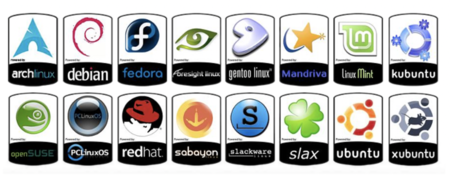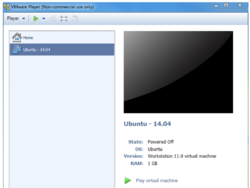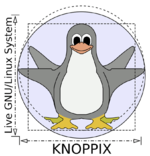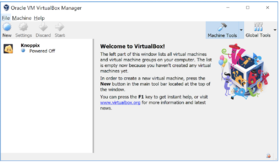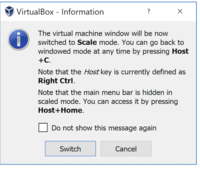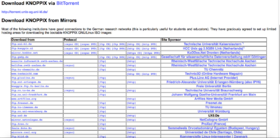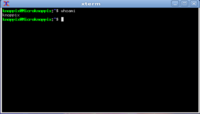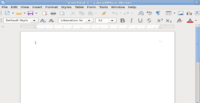Tutorial7: Installing Linux / Live Linux / Virtualization
Contents
INSTALLING LINUX / LIVE LINUX / VIRTUALIZATION
Main Objectives of this Practice Tutorial
- List and explain the common types of installing Linux
- Define and explain the purpose of using a Live Linux distribution
- Define and explain the purpose of Virtualization
- Boot the Knoppix Live Linux distribution from MyApps
Tutorial Reference Material
| Course Notes |
Concepts |
YouTube Videos | ||
| Course Notes: | Installing Linux
|
Software
|
Instructional Videos:
| |
KEY CONCEPTS
Installing Linux
Having your own Linux system offers a Linux student a great learning opportunity and gives you access to a large library of open source software.
You can also install different versions of a Linux system including a graphical desktop version, server version, etc.
Installing your own version of Linux on your notebook or desktop computer at home can also help for working
in the Linux environment and learn how to perform routine Linux OS administration tasks.
A Linux distribution (often abbreviated as distro) is an operating system made from a software collection that is based upon the Linux kernel and, often, a package management system. Linux users usually obtain their operating system by downloading one of the Linux distributions, which are available for a wide variety of systems ranging from embedded devices (for example, OpenWrt) and personal computers (for example, Linux Mint) to powerful supercomputers (for example, Rocks Cluster Distribution).
Reference: https://en.wikipedia.org/wiki/Linux_distribution
Steps in the Linux Installation Process:
- Select a Linux Distribution and download a Linux Distribution Install ISO file
to your Computer (Note: Be aware of any required Hardware Requirements for the Linux OS prior to installation.) - Burn an Linux Distribution CD/DVD, or USB, or use downloaded file when creating a virtual machine
- Once booted, the installation process transfers the live image to a disk (or flash memory) and configures the system
- For most distributions, the installation involves a guided graphical environment help assist with the Linux installation process
Linux Installation Methods
Standalone Installation
- Linux is the only OS on the computer
- Any existing data on disk will be erased
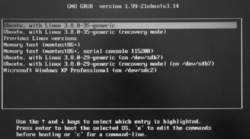
(Image licensed under cc)
Dual-boot / Multi-boot Installation
- A boot menu allows the user to select the desired OS
- This options provides a method to still use your computer if one OS fails to boot-up
- Most Linux distributions can access the Windows partition if your Windows OS cannot boot-up
- This option is great for troubleshooting: for example booting into other OS to confirm that you can connect to the Internet to rule-out hardware issues
- The installation process will take some of the free disk space from the OS already installed
- It is recommended to back up important data before proceeding
- It is recommended to install the Linux OS last, as other operating systems may not offer a multi-boot option
Virtualized Installation
- Virtualization requires a compatible processor – not all processors support that feature
- Most recent multi-core processors support virtualization
- The virtualized OS is installed and run in a window under another OS
- The installation can usually be completed from an ISO image
- One or more virtual machines can be run at the same time The guest OS shares the hardware with the host OS and possibly other virtualized systems
- Special software is used to manage the entire process, this is the “hypervisor”
- The guest systems have network access through the host
- The selection of virtualization software (which allows creation and running of virtual machines) depends mainly on the host OS, although some are cross-platform. Other considerations as to virtualization software may be features, support, price and/or personal preferences.
Popular VM software for Windows and MAC include:
- VMware
- Oracle Virtual Box
- KVM
- XEN
Live Linux CD
A live CD (also live DVD, live disc, or live operating system) is a complete bootable computer installation including operating system which runs directly from a CD-ROM or similar storage device into a computer's memory, rather than loading from a hard disk drive. A Live CD allows users to run an operating system for any purpose without installing it or making any changes to the computer's configuration. Live CDs can run on a computer without secondary storage, such as a hard disk drive, or with a corrupted hard disk drive or file system, allowing data recovery.
As CD and DVD drives have been steadily phased-out, live CDs have become less popular, being replaced by live USBs, which are equivalent systems written onto USB flash drives, which have the added benefit of having write-able storage. The functionality of a live CD is also available with a bootable live USB flash drive, or an external hard disk drive connected by USB.
Reference: https://en.wikipedia.org/wiki/Live_CD
The Knoppix Live CD id available to run on workstations at Seneca College or your home computer via AppsAnywhere.
- Steps to Run Knoppix from AppsAnywhere:
- Start your workstation in your lab and login to your Seneca Windows account.
- Click on the Search Apps area located in the top right corner of the MyApps window and type the word: knoppix
- Select the knoppix application icon and click Launch. Your file manager will open and display both the Knoppix virtual machine icon and a Knoppix Installation ISO file.
- Double-click on the icon Knoppix.vbox The Virtualbox application will launch and display the virtual machine for Knoppix.
- Double-click on the Knoppix VM in the left window to launch this VM and click the Switch button when prompted to enter scale mode.
You can also burn in a Knoppix CD or USB Live Image to Run on your Computer
- Steps to Run Knoppix Live from Your Computer:
- Click on the following link to download the lastest knoppix ISO:
https://www.knopper.net/knoppix-mirrors/index-en.html - If you are burning to a CD, click on the following link for instructions:
Install Knoppix LInux
NOTE: If you are burning to a USB, click on the following link for instructions:
How to Boot Knoppix from USB
INVESTIGATION 1: BOOTING KNOPPIX (LIVE LINUX) FROM MYAPPS
In this section, you will learn how to launch the Knoppix Live Linux distribution from a workstation as Seneca College using MyApps.
Perform the Following Steps:
- Start your workstation in your lab and login to your Seneca Windows account.
- Make certain that the MyApps window is open. This window should have opened shortly after you logged into your Windows workstation. If the application windows is not open, click on the MyApps icon on the desktop to launch).
- Click on the Search Apps area located in the top right corner of the MyApps window and type the word: knoppix
- The Knoppix Linux Distribution will appear.
NOTE: All of these applications allow you to connect to your Matrix account.
We will use the application called SSH Secure Shell Client for this practice tutorial. - Launch the Knoppix Linux distribution by clicking the Launch button.
NOTE: Your file manager will open and display both the Knoppix virtual machine icon and a Knoppix Installation ISO file. You will be launching the Knoppix Virtual machine in the Virtualbox application. - Double-click on the icon Knoppix.vbox in the Virtualbox menu.
- Another dialog box will appear. Double-click on the Switch button when prompted to enter scale mode.
NOTE: You should notice that you can switch between your Knoppix VM and your Windows computer which is referred to as the host machine. - Allow a little time for the Knoppix Linux distribution to start. This is a graphical Linux distribution which will start-up in a desktop environment.
NOTE: You are NOT prompted for a username and password because this is a Linux Live distribution,
and you have been assigned a generic account.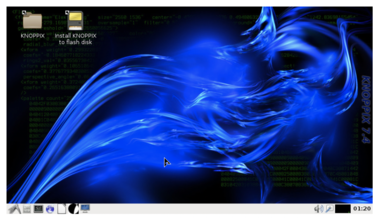 The Knoppix Linux desktop environment has a similar look as the MS Windows desktop environment.
The Knoppix Linux desktop environment has a similar look as the MS Windows desktop environment.
(Image licensed undercc) - On the bottom left-hand side, click on the Knoppix start menu (similar to the Windows start menu).
- In the start menu, select System Tools
- In the system tools menu, scroll down and select to launch the terminal application called xterm
- In the bash shell, issue the following Linux command: whoami
What is the name of your generic Knoppix Linux Live account? - Issue the following command to connect to your Matrix account (when prompted for your password, enter your MySeneca password as you do when checking your MySeneca email. NOTE: Nothing appears on the screen as you type your password but ensure you press Enter when done.): ssh yourSenecaId@matrix.senecacollege.ca
Where you able to connect to your Matrix account? - After logging in to your Matrix account, issue the following command to terminate your Matrix session: exit
- Make certain to close your xterm application.
- Use the Knoppix start menu to launch a web-browser and go to the Google website.
- Use the Knoppix start menu to select Office and then select LibreOffice - Writer to launch a word processor application.
- Create a small document and save changes to your home directory using your first name, and exit the Libreoffice word processing document.
- Use the Knoppix start menu to select logout, then select shutdown to terminate your Knoppix Linux Live session.
- Repeat the steps to launch a new Knoppix Linux Live session.
- Use the Knoppix start menu to launch a graphical file manager called x.
- Search for the word processing document that you saved on your home directory. Is there document there. If not, why?
- Use the Knoppix start menu to shutdown your Knoppix Linux Live session.
- Work on the Linux practice questions located at the bottom of this tutorial.
LINUX PRACTICE QUESTIONS
The purpose of this section is to obtain extra practice to help with quizzes, your midterm, and your final exam.
Here is a link to the MS Word Document of ALL of the questions displayed below but with extra room to answer on the document to simulate a quiz:
https://ict.senecacollege.ca/~murray.saul/uli101/uli101_week7_practice.docx
Your instructor may take-up these questions during class. It is up to the student to attend classes in order to obtain the answers to the following questions. Your instructor will NOT provide these answers in any other form (eg. e-mail, etc).
Review Questions:
- Define the term Linux Distribution.
- List and explain two advantages of installing a Linux distribution on your home computer or laptop.
- List and explain two things to consider prior to installing a Linux distribution on your home computer.
- Explain why installing Multi-boot for Linux is useful for computer troubleshooting.
- Define the term Virtualization.
- List the steps to boot the Knoppix Linux distribution from a Workstation at Seneca College.
- List the steps to boot the Knoppix Linux distribution from a CD or USB from your home computer.
- List the home pages of the Linux distributions shown in the Linux distribution image above.
